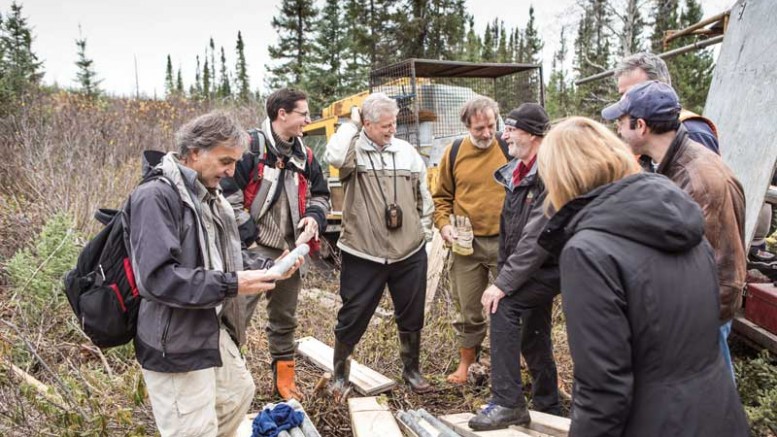VANCOUVER — John Kaiser, newsletter writer of Kaiser Research Online, spoke at this year’s Vancouver Commodity Forum — hosted by Zimtu Capital in downtown Vancouver in June — and shared his thoughts on why discovery stories are making a comeback among junior explorers.
“Discovery exploration is what the space used to be all about in the 1980s and 1990s, where the idea was to generate a prospect, find a target and hopefully make a discovery that would get bought out by a major before delivering the first resource estimate,” he told the audience during a presentation at the event.
The latest example occurred in 2004, when Virginia Gold Mines discovered the Éléonore gold deposit in the James Bay region of Quebec. In 2006, the project was scooped up by Goldcorp for US$420 million.
Since then, there have been few major discoveries, despite a surge in exploration investment across the resource sector. Kaiser reckons this is because deposits are becoming harder to find, and the use of traditional exploration techniques — such as prospecting and surface sampling — just doesn’t cut it anymore.
Instead, he says, many companies are sitting idle with “projects that are worth zero at US$1,200 per oz. gold.”

Drillers at Arizona Mining’s Taylor zinc-lead-silver deposit in Arizona. Credit: Arizona Mining.
“Companies shouldn’t listen to Rick Rule and his nonsense about ‘shut down everything, go into hibernation and wait for gold to come up,’” he said. “If so, they’ll probably get swallowed up by some mineral bank, the shareholders may get 50% or 100% markup on the stock, but their optionality on the project’s greater potential would vanish.”
He suggests that companies could get greater value from their assets by “raising the risk capital, putting your geologists to work and drilling where others found nothing in the past.”
He adds that “junior explorers need to ask themselves whether they really understand the whole extent of the mineralizing system … perhaps there’s room for something bigger and better than what they already have.”
He used Probe Mines’ Borden Lake gold project, near Chapleau, Ont., as an example of an open-pittable, disseminated gold deposit of nearly 4 million oz. gold that he says became “worthless” as the gold price dropped below US$1,200 per ounce.
Probe continued exploration and in late 2012 discovered a higher-grade mineralization zone beneath the open-pit resource, which measured 1.6 million oz. gold in 9.3 million indicated tonnes at 5.39 grams gold. The upgrade was enough to attract a $526-million buyout from Goldcorp last year.
A “classic example” of a company flipping a project, he added, would be what Robert Friedland’s Ivanhoe Mines did in 2001 at its Oyu Tolgoi porphyry copper-gold project in Mongolia’s South Gobi desert.

“Junior explorers need to ask themselves whether they really understand the whole extent of the mineralizing system.”
John Kaiser
Newsletter writer,
Kaiser Research Online
“Oyu Tolgoi was a piece of garbage that BHP Billiton unloaded onto Friedland. But he bought it, got his geologists to work and found the Hugo Dummett zone, which was five times bigger and better than what they originally had. That discovery alone took the company to a $4 billion valuation,” he said.
“The trick is for junior companies to apply new exploration methods to generate targets that no one has seen before, and hopefully it will turn into a discovery,” he continued. “I want the geologists to tell me a convincing story about why their region is so interesting and what makes their target so special. If they can’t teach me Geology 101, they don’t deserve to be in charge of an exploration junior.”
Kaiser points out that 703 out of the 1,500 resource sector companies listed on the TSX Venture Exchange in the past five years had negative working capital totalling $2.4 billion.
“These are the zombie companies that will never pay back the money and have no chance of going anywhere,” he said. “But there’s a big change that’s happening, and we’re not going to have the same number of explorers as before. New professionals are entering into the equation and the pretend-lifestyle guys won’t be able to compete with them.”

Virginia Gold Mines’ exploration camp at the Éléonore gold project in 2005. The project was bought by Goldcorp in 2006 and developed into an operating mine in Quebec’s James Bay region. Photo by The Northern Miner Staff.
He offered Arizona Mining, Sirios Resources and Nevada Exploration as “excellent” examples of juniors that are taking an innovative approach to exploration.
Last year, Arizona discovered carbonate replacement zinc-lead-silver mineralization downdip of its Central manto-style oxide silver deposit, 80 km southeast of Tucson, Ariz., after reinterpreting historical data.
The newly defined Taylor zone hosts 34 million tonnes of 4.5% lead, 4.5% zinc, 0.1% copper and 66.91 grams silver per tonne, whereas the shallow, open-pittable Central deposit contains 60 million tonnes of 68 grams silver. According to a company presentation, only 17% of the target area at Taylor has been drilled.
In Quebec, geologists at Sirios are finding higher-grade structural trends at the company’s Cheechoo gold property — next door to Goldcorp’s Éléonore gold mine — that were largely untested during historical drilling. Latest drill results on the property highlighted 37.2 grams gold per tonne over 4.1 metres, and 31.8 grams gold over 6 metres.
Nevada Exploration is the first junior company in the U.S. state to create the largest groundwater geochemistry database and use it to explore for hidden, Carlin-style gold deposits. Interpretation of the data led the junior to acquire five properties in the region, including its flagship 38.2 sq. km Kelly Creek project, located along the Battle Mountain–Eureka gold trend, where exploration is ongoing.
“There’s a whole new expectation for what counts as a discovery exploration junior,” Kaiser said. “If juniors do good geological work and apply the risk capital, they could tag into something that could be worth an awful lot.”


Be the first to comment on "Explorers need to rethink their deposits, John Kaiser says"